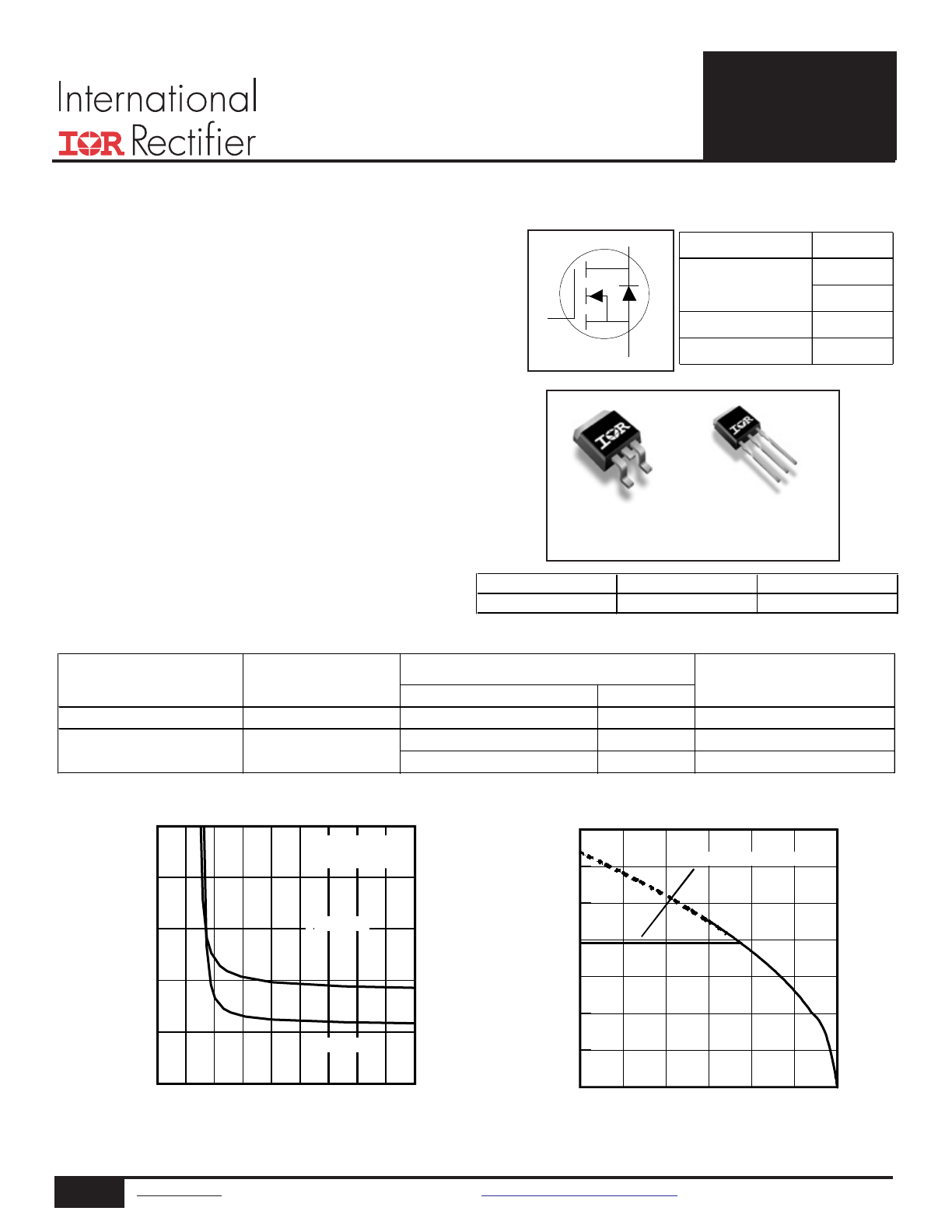
HEXFET
®
Power MOSFET
Benefits
l
Improved Gate, Avalanche and Dynamic dV/dt
Ruggedness
l
Fully Characterized Capacitance and Avalanche
SOA
l
Enhanced body diode dV/dt and dI/dt Capability
l
Lead-Free
G
D
S
Gate
Drain
Source
Fig 1. Typical On-Resistance vs. Gate Voltage
Fig 2. Maximum Drain Current vs. Case Temperature
Applications
l
Brushed Motor drive applications
l
BLDC Motor drive applications
l
Battery powered circuits
l
Half-bridge and full-bridge topologies
l
Synchronous rectifier applications
l
Resonant mode power supplies
l
OR-ing and redundant power switches
l
DC/DC and AC/DC converters
l
DC/AC Inverters
2
4
6
8
10
12
14
16
18
20
VGS, Gate -to -Source Voltage (V)
0
1
2
3
4
5
R
D
S
(o
n)
,
D
ra
in
-t
o
-S
ou
rc
e
O
n
R
es
is
ta
nc
e
(m
Ω
)
ID = 100A
TJ = 25°C
TJ = 125°C
D
S
G
IRFS7434PbF
IRFSL7434PbF
Strong
IR
FET
D
S
G
D
2
Pak
IRFS7434PbF
S
D
G
D
TO-262
IRFSL7434PbF
25
50
75
100
125
150
175
TC , Case Temperature (°C)
0
50
100
150
200
250
300
350
I D
,
D
ra
in
C
ur
re
nt
(
A
)
Limited By Package
Ordering Information
Form
Quantity
IRFSL7434PbF
TO-262
Tube
50
IRFSL7434PbF
Tube
50
IRFS7434PbF
Tape and Reel Left
800
IRFS7434TRLPbF
Base part number
Package Type
Standard Pack
Complete Part Number
D2Pak
IRFS7434PbF
1
www.irf.com
© 2014 International Rectifier
Submit Datasheet Feedback
November 19, 2014
V
DSS
40V
R
DS(on)
typ.
1.25mΩ
max.
1.6mΩ
I
D
(Silicon Limited)
320A
c
I
D
(Package Limited)
195A
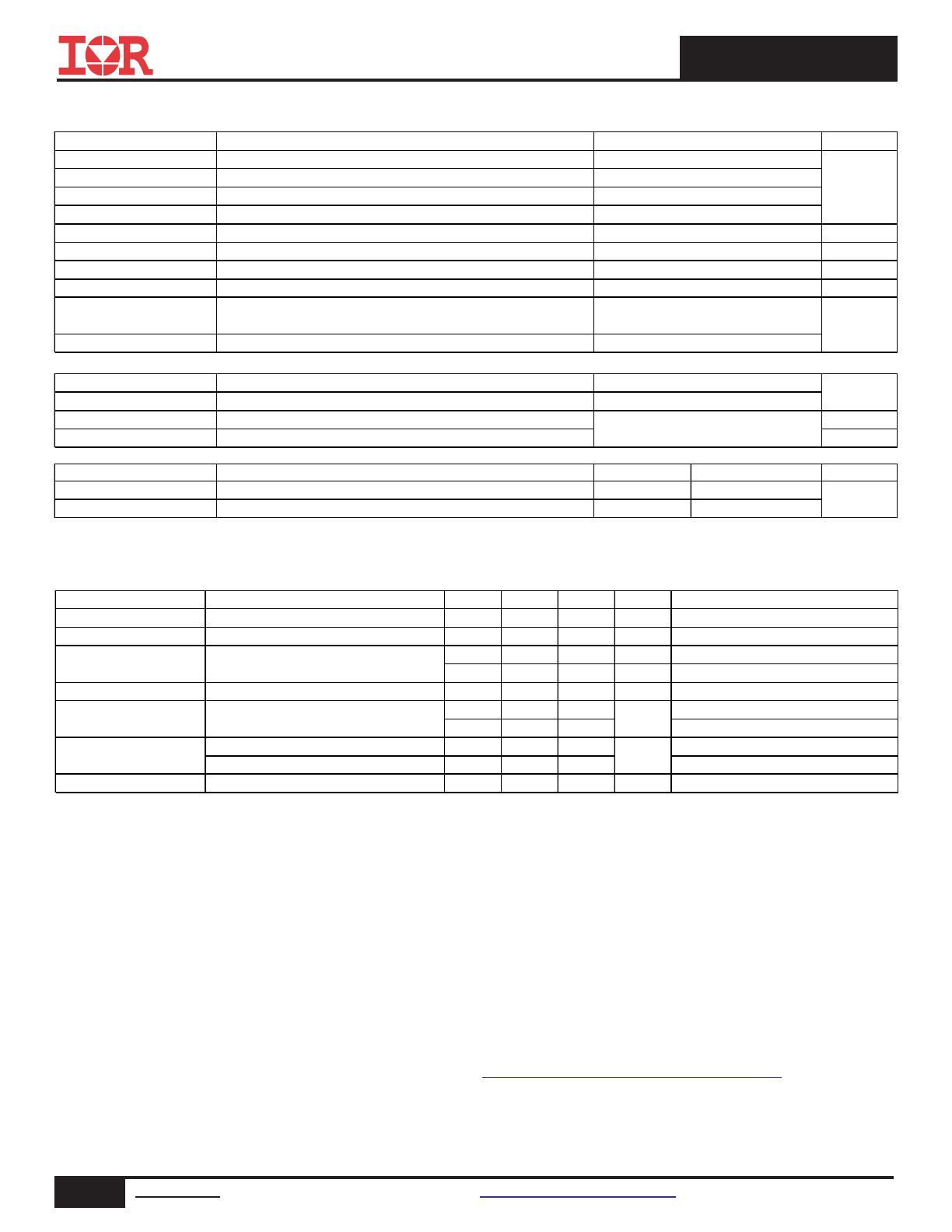
IRFS/SL7434PbF
www.irf.com
© 2014 International Rectifier
Submit Datasheet Feedback
November 19, 2014
2
Notes:
Calculated continuous current based on maximum allowable junction
temperature. Bond wire current limit is 195A
by source
bonding technology . Note that current limitations arising from
heating of the device leads may occur with some lead mounting
arrangements.
(Refer to AN-1140)
Repetitive rating; pulse width limited by max. junction
temperature.
Limited by T
Jmax
, starting T
J
= 25°C, L = 0.099mH
R
G
= 50
Ω, I
AS
= 100A, V
GS
=10V.
I
SD
≤ 100A, di/dt ≤ 1307A/μs, V
DD
≤ V
(BR)DSS
, T
J
≤ 175°C.
Pulse width ≤ 400μs; duty cycle ≤ 2%.
C
oss
eff. (TR) is a fixed capacitance that gives the same charging time
as C
oss
while V
DS
is rising from 0 to 80% V
DSS
.
C
oss
eff. (ER) is a fixed capacitance that gives the same energy as
C
oss
while V
DS
is rising from 0 to 80% V
DSS
.
R
θ
is measured at T
J
approximately 90°C.
Limited by T
Jmax
starting
T
J
= 25°C, L= 1mH, R
G
= 50
Ω, I
AS
= 47A, V
GS
=10V.
When mounted on 1" square PCB (FR-4 or G-10 Material).
Please refer to AN-994 for more details:
http://www.irf.com/technical-info/appnotes/an-994.pdf
∗
Pulse drain current is limited at 780A by source bonding technology.
Absolute Maximum Ratings
Symbol
Parameter
Units
I
D
@ T
C
= 25°C
Continuous Drain Current, V
GS
@ 10V (Silicon Limited)
I
D
@ T
C
= 100°C
Continuous Drain Current, V
GS
@ 10V (Silicon Limited)
I
D
@ T
C
= 25°C
Continuous Drain Current, V
GS
@ 10V (Wire Bond Limited)
I
DM
Pulsed Drain Current
d
P
D
@T
C
= 25°C
Maximum Power Dissipation
W
Linear Derating Factor
W/°C
V
GS
Gate-to-Source Voltage
V
dv/dt
Peak Diode Recovery
f
V/ns
T
J
Operating Junction and
T
STG
Storage Temperature Range
Soldering Temperature, for 10 seconds (1.6mm from case)
Avalanche Characteristics
E
AS (Thermally limited)
Single Pulse Avalanche Energy e
mJ
E
AS (Thermally limited)
Single Pulse Avalanche Energy k
I
AR
Avalanche Currentd
A
E
AR
Repetitive Avalanche Energy d
mJ
Thermal Resistance
Symbol
Parameter
Typ.
Max.
Units
R
θJC
Junction-to-Case j
–––
0.5
R
θJA
Junction-to-Ambient (PCB Mount) , D
2
Pak l
–––
40
°C/W
Max.
320
c
226
c
1270 *
195
1098
-55 to + 175
± 20
1.96
See Fig. 14, 15 , 22a, 22b
A
°C
300
490
294
5.0
Static @ T
J
= 25°C (unless otherwise specified)
Symbol
Parameter
Min.
Typ.
Max.
Units
V
(BR)DSS
Drain-to-Source Breakdown Voltage
40
–––
–––
V
ΔV
(BR)DSS
/
ΔT
J
Breakdown Voltage Temp. Coefficient
–––
32
–––
mV/°C
R
DS(on)
Static Drain-to-Source On-Resistance
–––
1.25
1.6
m
Ω
1.8
–––
m
Ω
V
GS(th)
Gate Threshold Voltage
2.2
3.0
3.9
V
I
DSS
Drain-to-Source Leakage Current
–––
–––
1.0
–––
–––
150
I
GSS
Gate-to-Source Forward Leakage
–––
–––
100
Gate-to-Source Reverse Leakage
–––
–––
-100
R
G
Internal Gate Resistance
–––
2.1
–––
Ω
Conditions
V
GS
= 0V, I
D
= 250μA
Reference to 25°C, I
D
= 5mA
d
V
GS
= 10V, I
D
= 100A
g
V
GS
= 6.0V, I
D
= 50A
g
V
DS
= V
GS
, I
D
= 250μA
μA
nA
V
DS
= 40V, V
GS
= 0V
V
DS
= 40V, V
GS
= 0V, T
J
= 125°C
V
GS
= 20V
V
GS
= -20V
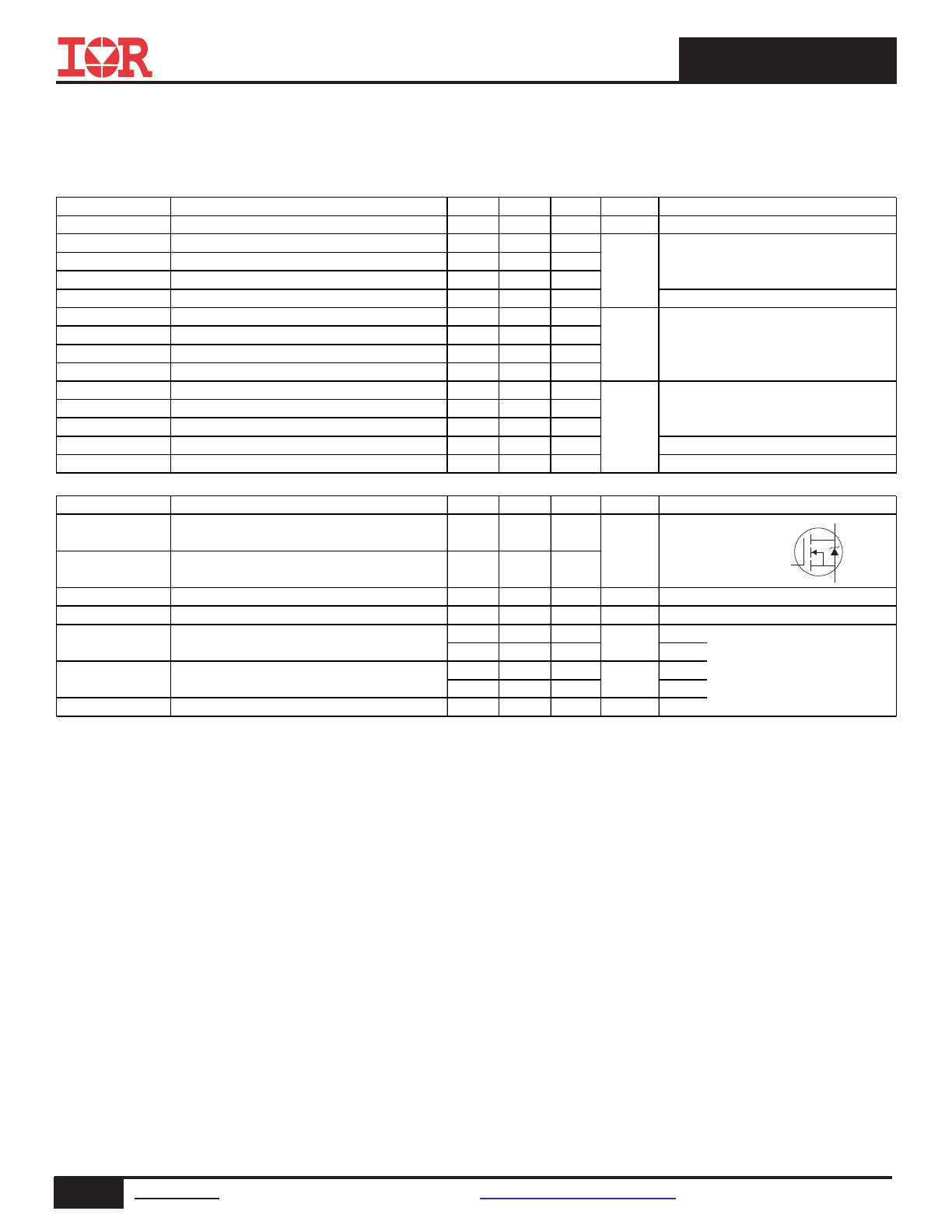
IRFS/SL7434PbF
3
www.irf.com
© 2014 International Rectifier
Submit Datasheet Feedback
November 19, 2014
S
D
G
Dynamic @ T
J
= 25°C (unless otherwise specified)
Symbol
Parameter
Min.
Typ.
Max.
Units
gfs
Forward Transconductance
211
–––
–––
S
Q
g
Total Gate Charge
–––
216
324
Q
gs
Gate-to-Source Charge
–––
51
–––
Q
gd
Gate-to-Drain ("Miller") Charge
–––
77
–––
Q
sync
Total Gate Charge Sync. (Q
g
- Q
gd
)
–––
139
–––
t
d(on)
Turn-On Delay Time
–––
24
–––
t
r
Rise Time
–––
68
–––
t
d(off)
Turn-Off Delay Time
–––
115
–––
t
f
Fall Time
–––
68
–––
C
iss
Input Capacitance
–––
10820
–––
C
oss
Output Capacitance
–––
1540
–––
C
rss
Reverse Transfer Capacitance
–––
1140
–––
C
oss
eff. (ER)
Effective Output Capacitance (Energy Related)
–––
1880
–––
C
oss
eff. (TR)
Effective Output Capacitance (Time Related)
–––
2208
–––
Diode Characteristics
Symbol
Parameter
Min.
Typ.
Max.
Units
I
S
Continuous Source Current
(Body Diode)
I
SM
Pulsed Source Current
(Body Diode)d
V
SD
Diode Forward Voltage
–––
0.9
1.3
V
dv/dt
Peak Diode Recoveryf
–––
5.0
–––
V/ns
t
rr
Reverse Recovery Time
–––
38
–––
T
J
= 25°C
V
R
= 34V,
–––
37
–––
T
J
= 125°C
I
F
= 100A
Q
rr
Reverse Recovery Charge
–––
50
–––
T
J
= 25°C
di/dt = 100A/μs g
–––
50
–––
T
J
= 125°C
I
RRM
Reverse Recovery Current
–––
1.9
–––
A
T
J
= 25°C
T
J
= 175°C, I
S
= 100A, V
DS
= 40V
Conditions
V
DS
= 10V, I
D
= 100A
I
D
= 100A
V
DS
=20V
V
GS
= 10V
g
V
DD
= 20V
I
D
= 100A, V
DS
=0V, V
GS
= 10V
T
J
= 25°C, I
S
= 100A, V
GS
= 0V g
integral reverse
p-n junction diode.
MOSFET symbol
showing the
I
D
= 30A
R
G
= 2.7
Ω
Conditions
V
GS
= 10V
g
V
GS
= 0V
nC
ns
pF
V
DS
= 25V
ƒ = 1.0 MHz, See Fig. 5
V
GS
= 0V, V
DS
= 0V to 32V
i, See Fig. 12
V
GS
= 0V, V
DS
= 0V to 32V
h
A
ns
nC
320c
–––
–––
–––
–––
1270*
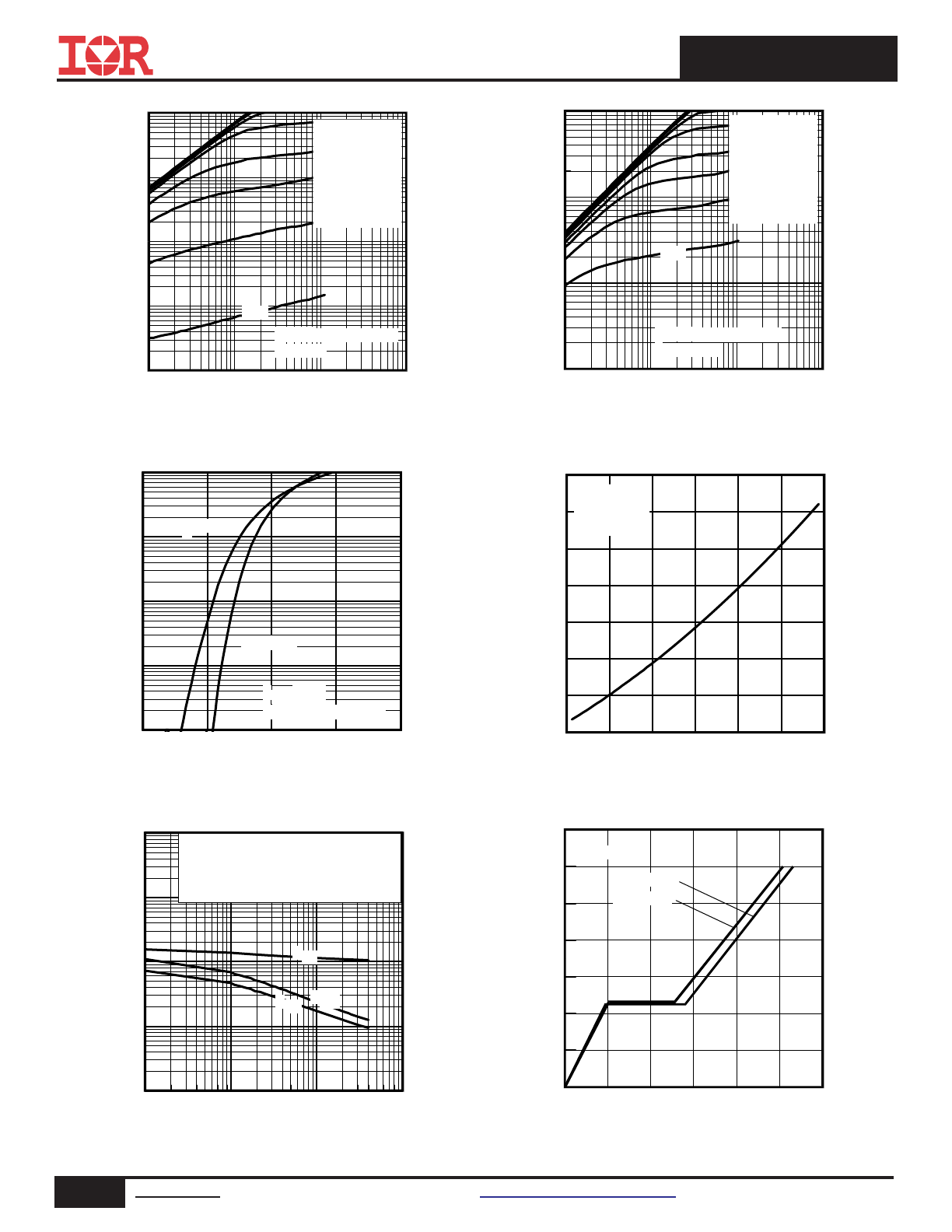
IRFS/SL7434PbF
www.irf.com
© 2014 International Rectifier
Submit Datasheet Feedback
November 19, 2014
4
Fig 3. Typical Output Characteristics
Fig 5. Typical Transfer Characteristics
Fig 6. Normalized On-Resistance vs. Temperature
Fig 4. Typical Output Characteristics
Fig 8. Typical Gate Charge vs. Gate-to-Source Voltage
Fig 7. Typical Capacitance vs. Drain-to-Source Voltage
0.1
1
10
100
VDS, Drain-to-Source Voltage (V)
0.1
1
10
100
1000
I D
, D
ra
in
-t
o-
S
ou
rc
e
C
ur
re
nt
(
A
)
VGS
TOP
15V
10V
8.0V
7.0V
6.0V
5.5V
5.0V
BOTTOM
4.5V
≤60μs
PULSE WIDTH
Tj = 25°C
4.5V
0.1
1
10
100
VDS, Drain-to-Source Voltage (V)
1
10
100
1000
I D
, D
ra
in
-t
o-
S
ou
rc
e
C
ur
re
nt
(
A
)
4.5V
≤60μs
PULSE WIDTH
Tj = 175°C
VGS
TOP
15V
10V
8.0V
7.0V
6.0V
5.5V
5.0V
BOTTOM
4.5V
2
4
6
8
10
VGS, Gate-to-Source Voltage (V)
0.1
1
10
100
1000
I D
, D
ra
in
-t
o-
S
ou
rc
e
C
ur
re
nt
(
A
)
TJ = 25°C
TJ = 175°C
VDS = 10V
≤60μs PULSE WIDTH
-60
-20
20
60
100
140
180
TJ , Junction Temperature (°C)
0.6
0.8
1.0
1.2
1.4
1.6
1.8
2.0
R
D
S
(o
n)
,
D
ra
in
-t
o-
S
ou
rc
e
O
n
R
es
is
ta
nc
e
(
N
or
m
al
iz
ed
)
ID = 100A
VGS = 10V
0
50
100
150
200
250
300
QG, Total Gate Charge (nC)
0.0
2.0
4.0
6.0
8.0
10.0
12.0
14.0
V
G
S
, G
at
e-
to
-S
ou
rc
e
V
ol
ta
ge
(
V
)
VDS= 32V
VDS= 20V
ID= 100A
0.1
1
10
100
VDS, Drain-to-Source Voltage (V)
100
1000
10000
100000
1000000
C
, C
ap
ac
ita
nc
e
(p
F
)
VGS = 0V, f = 1 MHZ
Ciss = Cgs + Cgd, C ds SHORTED
Crss = Cgd
Coss = Cds + Cgd
Coss
Crss
Ciss
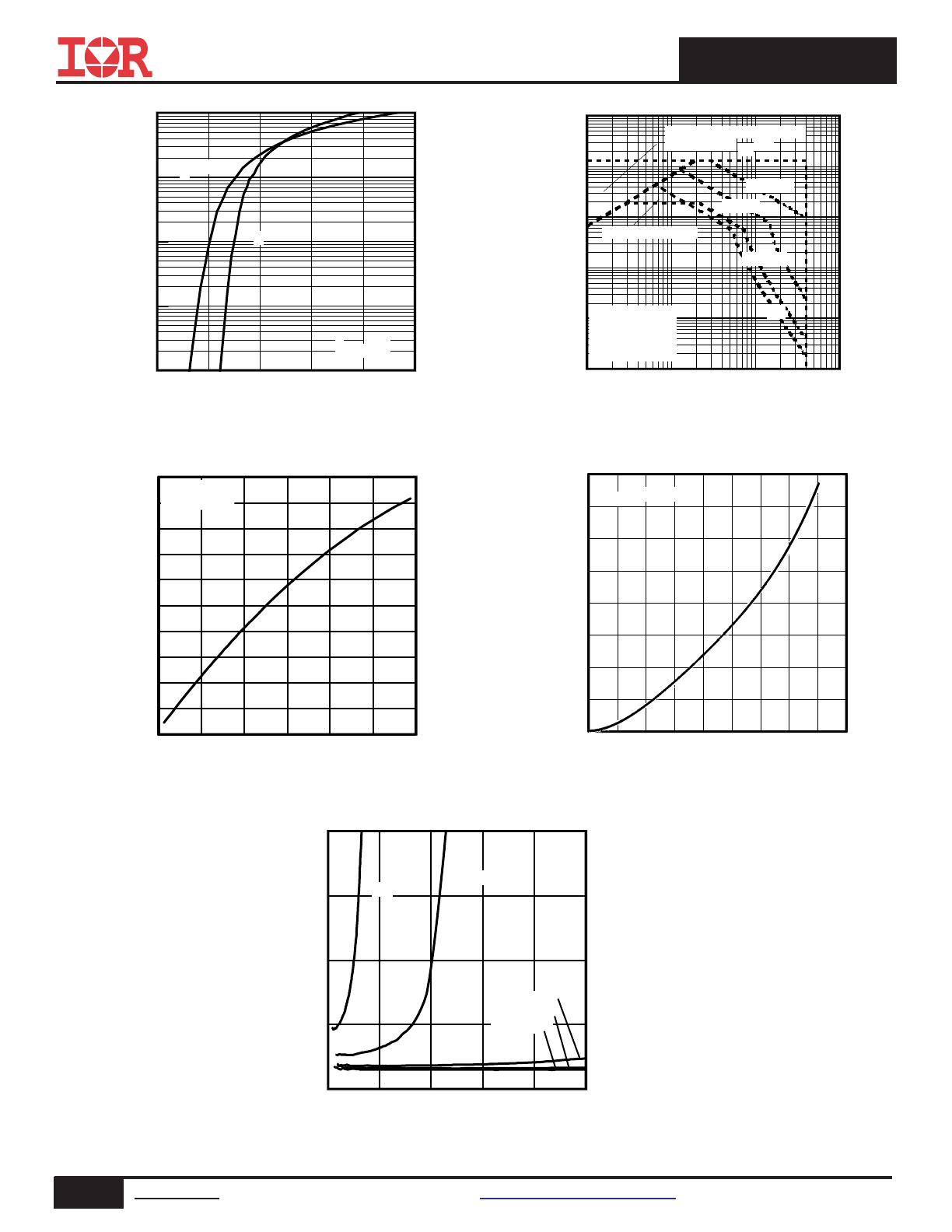
IRFS/SL7434PbF
5
www.irf.com
© 2014 International Rectifier
Submit Datasheet Feedback
November 19, 2014
Fig 10. Maximum Safe Operating Area
Fig 11. Drain-to-Source Breakdown Voltage
Fig 9. Typical Source-Drain Diode
Forward Voltage
Fig 12. Typical C
OSS
Stored Energy
Fig 13. Typical On-Resistance vs. Drain Current
0.0
0.5
1.0
1.5
2.0
2.5
VSD, Source-to-Drain Voltage (V)
0.1
1
10
100
1000
I S
D
, R
ev
er
se
D
ra
in
C
ur
re
nt
(
A
)
TJ = 25°C
TJ = 175°C
VGS = 0V
0.1
1
10
100
VDS, Drain-to-Source Voltage (V)
0.1
1
10
100
1000
10000
I D
,
D
ra
in
-t
o-
S
ou
rc
e
C
ur
re
nt
(
A
)
Tc = 25°C
Tj = 175°C
Single Pulse
10msec
1msec
OPERATION IN THIS AREA
LIMITED BY R DS(on)
100μsec
DC
Limited By Package
0
100
200
300
400
500
ID, Drain Current (A)
0.0
5.0
10.0
15.0
20.0
R
D
S
(o
n)
,
D
ra
in
-t
o
-S
ou
rc
e
O
n
R
es
is
ta
nc
e
(m
Ω
)
VGS = 7.0V
VGS = 8.0V
VGS = 10V
VGS = 6.0V
VGS = 5.5V
-60
-20
20
60
100
140
180
TJ , Temperature ( °C )
40
41
42
43
44
45
46
47
48
49
50
V
(B
R
)D
S
S
, D
ra
in
-t
o-
S
ou
rc
e
B
re
ak
do
w
n
V
ol
ta
ge
(
V
)
Id = 5.0mA
0
5
10
15
20
25
30
35
40
45
VDS, Drain-to-Source Voltage (V)
0.0
0.2
0.4
0.6
0.8
1.0
1.2
1.4
1.6
E
ne
rg
y
(μ
J)
VDS= 0V to 32V
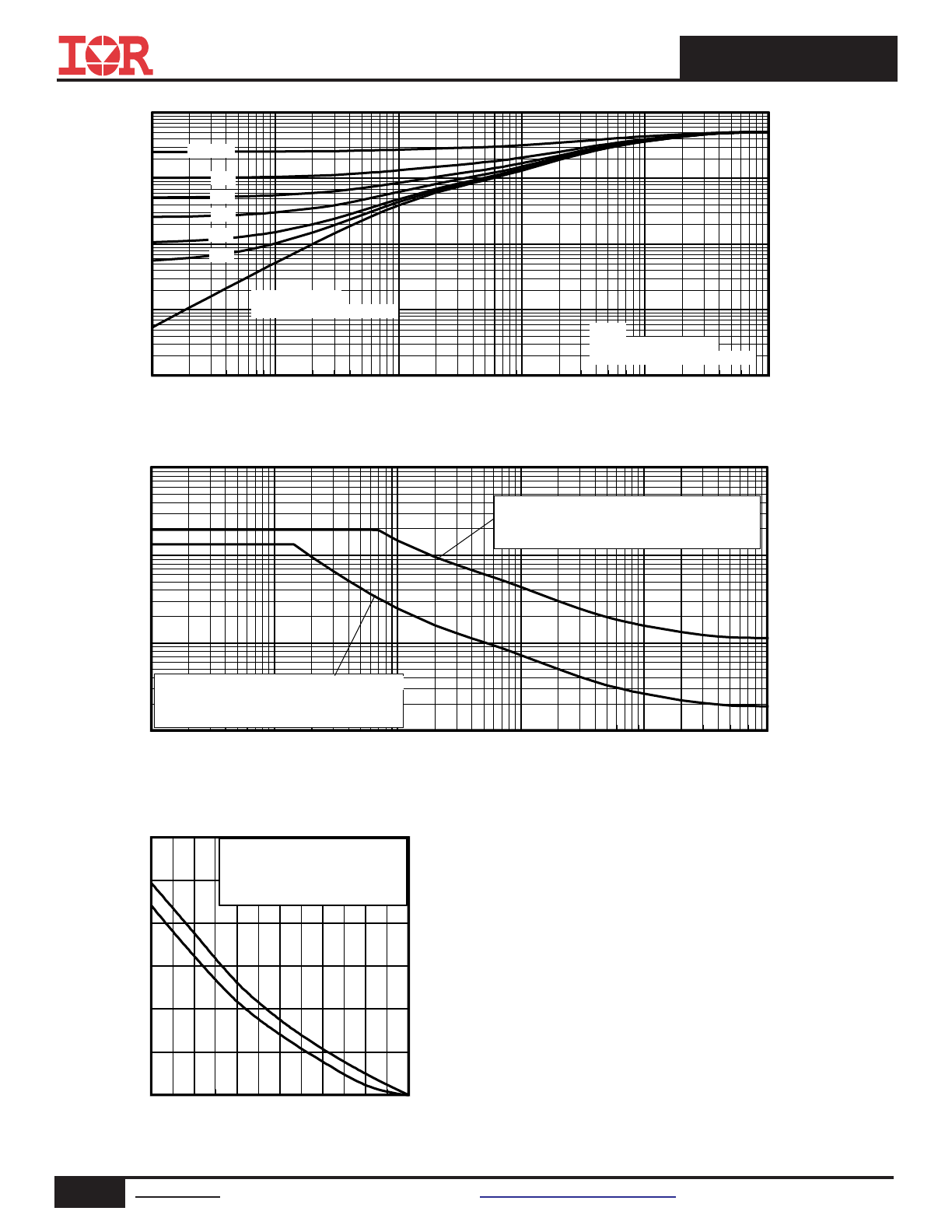
IRFS/SL7434PbF
www.irf.com
© 2014 International Rectifier
Submit Datasheet Feedback
November 19, 2014
6
Fig 13. Maximum Effective Transient Thermal Impedance, Junction-to-Case
Fig 14. Avalanche Current vs.Pulse width
Fig 15. Maximum Avalanche Energy vs. Temperature
Notes on Repetitive Avalanche Curves , Figures 14, 15:
(For further info, see AN-1005 at www.irf.com)
1. Avalanche failures assumption:
Purely a thermal phenomenon and failure occurs at a temperature far in
excess of T
jmax
. This is validated for every part type.
2. Safe operation in Avalanche is allowed as long asT
jmax
is not exceeded.
3. Equation below based on circuit and waveforms shown in Figures 22a, 22b.
4. P
D (ave)
= Average power dissipation per single avalanche pulse.
5. BV = Rated breakdown voltage (1.3 factor accounts for voltage increase
during avalanche).
6. I
av
= Allowable avalanche current.
7.
ΔT
=
Allowable rise in junction temperature, not to exceed
T
jmax
(assumed as
25°C in Figure 14, 15).
t
av =
Average time in avalanche.
D = Duty cycle in avalanche = t
av
·f
Z
thJC
(D, t
av
) = Transient thermal resistance, see Figures 13)
P
D (ave)
= 1/2 ( 1.3·BV·I
av
) =
DT/ Z
thJC
I
av
=
2
DT/ [1.3·BV·Z
th
]
E
AS (AR)
= P
D (ave)
·t
av
1E-006
1E-005
0.0001
0.001
0.01
0.1
t1 , Rectangular Pulse Duration (sec)
0.0001
0.001
0.01
0.1
1
T
he
rm
al
R
es
po
ns
e
(
Z
th
JC
)
°
C
/W
0.20
0.10
D = 0.50
0.02
0.01
0.05
SINGLE PULSE
( THERMAL RESPONSE )
Notes:
1. Duty Factor D = t1/t2
2. Peak Tj = P dm x Zthjc + Tc
1.0E-06
1.0E-05
1.0E-04
1.0E-03
1.0E-02
1.0E-01
tav (sec)
1
10
100
1000
A
va
la
nc
he
C
ur
re
nt
(
A
)
Allowed avalanche Current vs avalanche
pulsewidth, tav, assuming
ΔΤj = 25°C and
Tstart = 150°C.
Allowed avalanche Current vs avalanche
pulsewidth, tav, assuming
ΔTj = 150°C and
Tstart =25°C (Single Pulse)
25
50
75
100
125
150
175
Starting TJ , Junction Temperature (°C)
0
100
200
300
400
500
600
E
A
R
,
A
va
la
nc
he
E
ne
rg
y
(m
J)
TOP Single Pulse
BOTTOM 1.0% Duty Cycle
ID = 100A
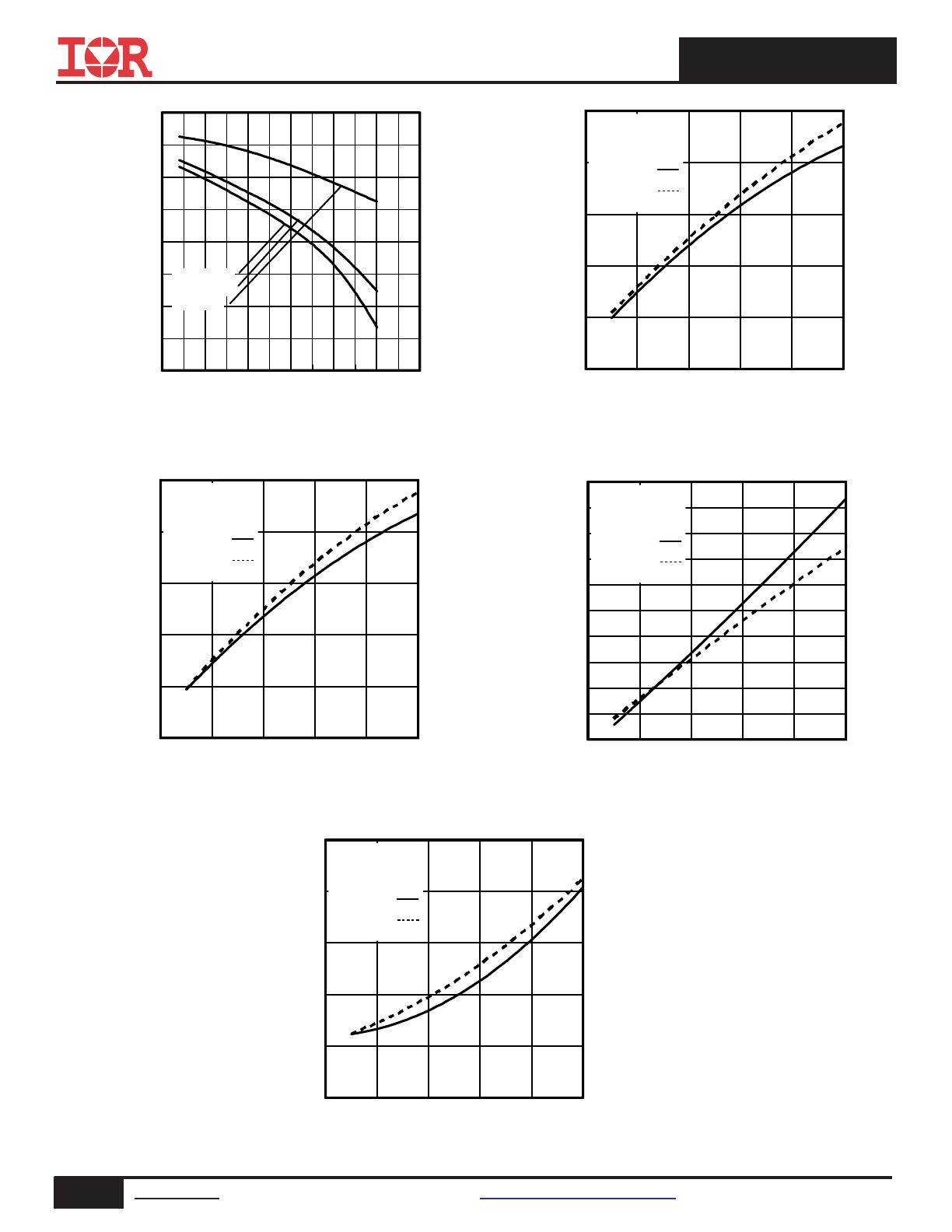
IRFS/SL7434PbF
7
www.irf.com
© 2014 International Rectifier
Submit Datasheet Feedback
November 19, 2014
Fig. 17 - Typical Recovery Current vs. di
f
/dt
Fig 16. Threshold Voltage vs. Temperature
Fig. 19 - Typical Stored Charge vs. di
f
/dt
Fig. 18 - Typical Recovery Current vs. di
f
/dt
Fig. 20 - Typical Stored Charge vs. di
f
/dt
-75
-25
25
75
125
175
225
TJ , Temperature ( °C )
0.5
1.5
2.5
3.5
4.5
V
G
S
(t
h)
, G
at
e
th
re
sh
ol
d
V
ol
ta
ge
(
V
)
ID = 250μA
ID = 1.0mA
ID = 1.0A
0
200
400
600
800
1000
diF /dt (A/μs)
0
2
4
6
8
10
I R
R
M
(
A
)
IF = 60A
VR = 34V
TJ = 25°C
TJ = 125°C
0
200
400
600
800
1000
diF /dt (A/μs)
0
2
4
6
8
10
I R
R
M
(
A
)
IF = 100A
VR = 34V
TJ = 25°C
TJ = 125°C
0
200
400
600
800
1000
diF /dt (A/μs)
40
60
80
100
120
140
160
180
200
220
240
Q
R
R
(
nC
)
IF = 60A
VR = 34V
TJ = 25°C
TJ = 125°C
0
200
400
600
800
1000
diF /dt (A/μs)
0
40
80
120
160
200
Q
R
R
(
nC
)
IF = 100A
VR = 34V
TJ = 25°C
TJ = 125°C
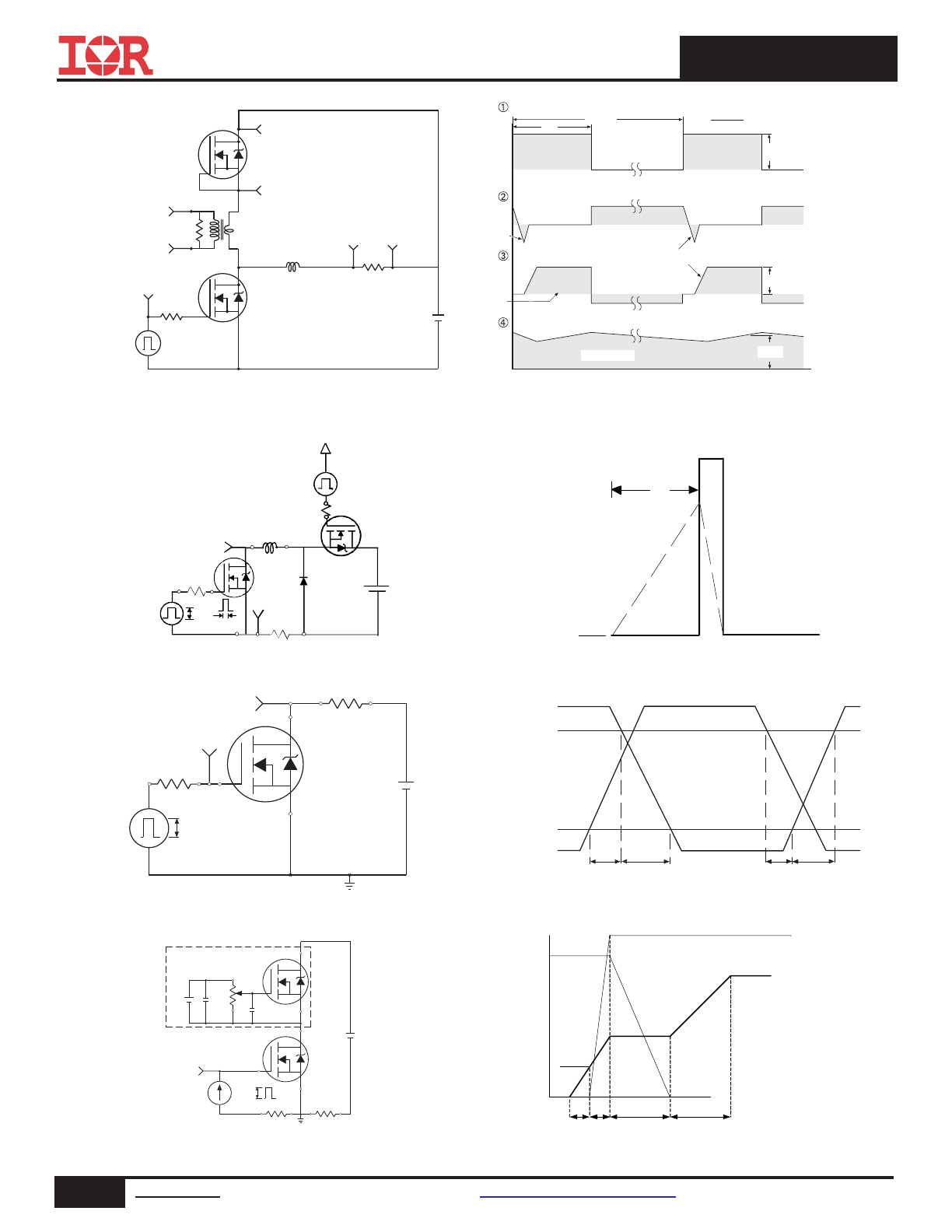
IRFS/SL7434PbF
www.irf.com
© 2014 International Rectifier
Submit Datasheet Feedback
November 19, 2014
8
Fig 23a. Switching Time Test Circuit
Fig 23b. Switching Time Waveforms
Fig 22b. Unclamped Inductive Waveforms
Fig 22a. Unclamped Inductive Test Circuit
tp
V
(BR)DSS
I
AS
RG
IAS
0.01
Ω
tp
D.U.T
L
VDS
+
- VDD
DRIVER
A
15V
20V
V
GS
Fig 24a. Gate Charge Test Circuit
Fig 24b. Gate Charge Waveform
Vds
Vgs
Id
Vgs(th)
Qgs1 Qgs2
Qgd
Qgodr
Fig 21.
Peak Diode Recovery dv/dt Test Circuit for N-Channel
HEXFET
®
Power MOSFETs
Circuit Layout Considerations
• Low Stray Inductance
• Ground Plane
• Low Leakage Inductance
Current Transformer
P.W.
Period
di/dt
Diode Recovery
dv/dt
Ripple
≤ 5%
Body Diode Forward Drop
Re-Applied
Voltage
Reverse
Recovery
Current
Body Diode Forward
Current
V
GS
=10V
V
DD
I
SD
Driver Gate Drive
D.U.T. I
SD
Waveform
D.U.T. V
DS
Waveform
Inductor Curent
D =
P.W.
Period
*
V
GS
= 5V for Logic Level Devices
*
+
-
+
+
+
-
-
-
R
G
V
DD
• dv/dt controlled by R
G
• Driver same type as D.U.T.
• I
SD
controlled by Duty Factor "D"
• D.U.T. - Device Under Test
D.U.T
Inductor Current
D.U.T.
V
DS
I
D
I
G
3mA
V
GS
.3
μF
50K
Ω
.2
μF
12V
Current Regulator
Same Type as D.U.T.
Current Sampling Resistors
+
-
V
DS
90%
10%
V
GS
t
d(on)
t
r
t
d(off)
t
f
V
DS
Pulse Width ≤ 1 µs
Duty Factor ≤ 0.1 %
R
D
V
GS
R
G
D.U.T.
10V
+
-
V
DD
V
GS
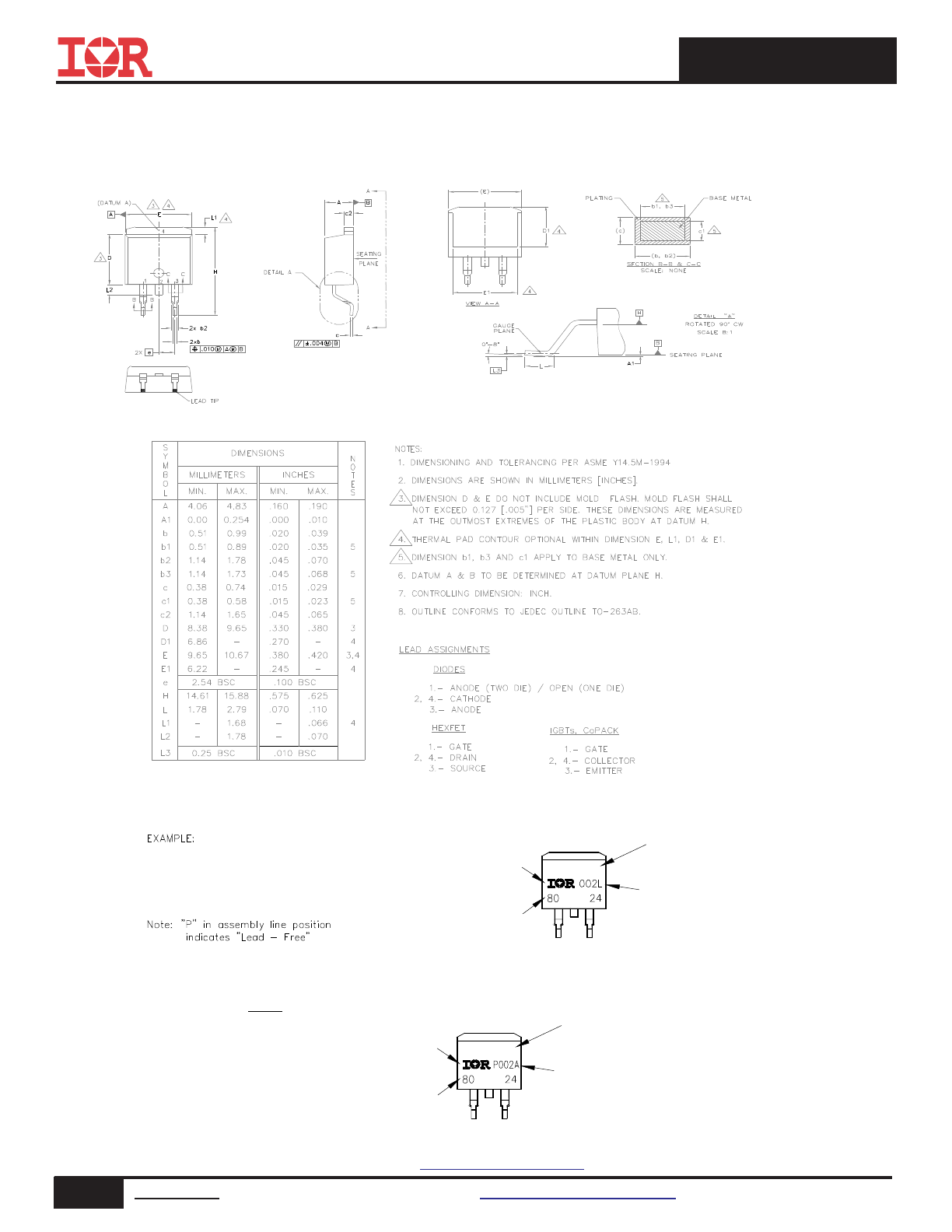
IRFS/SL7434PbF
9
www.irf.com
© 2014 International Rectifier
Submit Datasheet Feedback
November 19, 2014
D
2
Pak (TO-263AB) Part Marking Information
D
2
Pak (TO-263AB) Package Outline
Dimensions are shown in millimeters (inches)
DAT E CODE
YE AR 0 = 2000
WEEK 02
A = AS S E MB LY S IT E CODE
RECT IF IE R
INT ERNAT IONAL
PART NUMBER
P = DES IGNAT E S L EAD - F RE E
PRODUCT (OPT IONAL)
F 530S
IN T HE AS S EMB LY LINE "L"
AS S E MB LED ON WW 02, 2000
T HIS IS AN IRF 530S WIT H
L OT CODE 8024
INT ERNAT IONAL
L OGO
RECT IF IER
L OT CODE
AS S EMBL Y
YEAR 0 = 2000
PART NUMBER
DAT E CODE
LINE L
WEEK 02
OR
F 530S
L OGO
AS S EMBLY
LOT CODE
Note: For the most current drawing please refer to IR website at
http://www.irf.com/package/

IRFS/SL7434PbF
www.irf.com
© 2014 International Rectifier
Submit Datasheet Feedback
November 19, 2014
10
TO-262 Part Marking Information
TO-262 Package Outline
Dimensions are shown in millimeters (inches)
L OGO
R E CT IF IE R
INT E R NAT IONAL
L OT CODE
AS S E MB L Y
L OGO
R E CT IF IE R
INT E R NAT IONAL
DAT E CODE
WE E K 19
YE AR 7 = 1997
P AR T NU MB E R
A = AS S E MB L Y S IT E CODE
OR
PR ODU CT (OPT IONAL )
P = DE S IGNAT E S L E AD-F R E E
E XAMP L E : T H IS IS AN IR L 3103L
L OT CODE 1789
AS S E MB L Y
P AR T NU MB E R
DAT E CODE
WE E K 19
L INE C
L OT CODE
YE AR 7 = 1997
AS S E MB L E D ON WW 19, 1997
IN T H E AS S E MB L Y L INE "C"
Note: For the most current drawing please refer to IR website at
http://www.irf.com/package/
